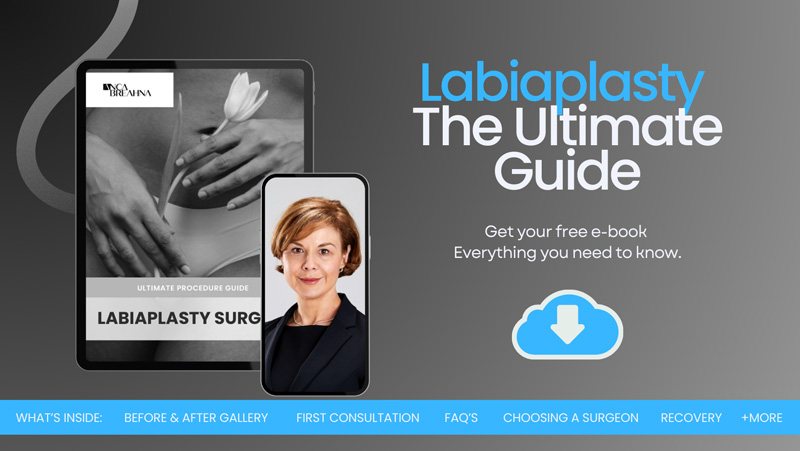
Table of Contents
- Different Techniques Used for Labiaplasty Surgery
- Download Anca Breahna’s Labiaplasty Guide
- What Is Labiaplasty?
- The Trim Method Labiaplasty
- Pros and Cons of Trim Labiaplasty
- Ideal Candidates for the Trim Method
- The Wedge Method Labiaplasty
- Pros and Cons
- Ideal Candidates for the Wedge Method
- Comparing Trim and Wedge Methods
- How to Choose the Right Labiaplasty Method for You
- FAQs about Trim and Wedge Methods for Labiaplasty
- Further Reading about Labiaplasty Surgery at Cheshire Cosmetic Surgery
Different Techniques Used for Labiaplasty Surgery
Labiaplasty is a surgical procedure aimed at altering the labia minora and/or labia majora, the outer and inner lips that surround the vulva. Many women consider this surgery for personal comfort or health concerns. Some might be motivated by discomfort during exercise or when wearing certain clothes, while others might be influenced by a desire for a certain appearance. In this blog, Chester Consultant Plastic Surgeon Anca Breahna will explore two main techniques used in labiaplasty: the trim method and the wedge method.
Download Anca Breahna’s Labiaplasty Guide

What Is Labiaplasty?
Labiaplasty is a surgical procedure that reshapes or reduces the size of the labia minora, the inner lips of the vulva, and sometimes the labia majora, the outer lips. The motivations for labiaplasty are varied. For some, it’s a matter of physical comfort. Activities like cycling, running, or even sitting for extended periods can be uncomfortable if the labia are elongated or asymmetrical. For others, aesthetic concerns may drive the decision. They might feel self-conscious about the appearance in tight clothing or swimwear. Additionally, some women seek labiaplasty after childbirth, as the labia can sometimes be stretched or altered during delivery.
Labiaplasty is usually performed as an outpatient procedure under local or general anaesthesia. The surgery takes about one to two hours, and patients can often go home the same day. Recovery time varies, but most women can return to work and light activities within a week. Full recovery, including resuming exercise and sexual activities, usually takes around six weeks.
The Trim Method Labiaplasty
When you’re looking into labiaplasty, one option you might come across is the trim method. This approach is pretty direct and no-nonsense. It involves cutting away the extra bits of the labia minora – those are the inner flaps of skin around the vaginal opening. The idea is to reduce their size, especially if they’re uneven or hanging down more than you’d like.
The procedure is quite straightforward. Anca carefully trims the excess tissue along the edge of the labia minora. This is done with precision, ensuring the final shape is symmetrical and meets your expectations. If you’re bothered by the size or shape of your labia minora, particularly if they’re significantly uneven or extended, this method could be a good fit.
Pros and Cons of Trim Labiaplasty
Like with any surgery, there are upsides and downsides to consider with the trim method.
Pros:
- Simplicity: The procedure is quite straightforward, which can be reassuring. There’s no complicated technique involved
- Effectiveness: It’s effective in reducing the size of the labia minora, especially if they’re quite long or asymmetrical
- Addressing Darkened Edges: If the darker edges of your labia are a concern, this method can reduce that appearance, as those parts are often removed during the trimming
On the flip side, there are a couple of things to keep in mind:
- Scarring: The main downside is that this method can leave a more noticeable scar along the edge of the labia. Scars are a normal part of healing, but they can be more visible with this technique
- Sensation Changes: There’s a chance that the sensation along the scar line might change. This doesn’t happen to everyone, but it’s a possibility to be aware of
Ideal Candidates for the Trim Method

The Trim Labiaplasty tends to work best for women who have a fair bit of asymmetry or elongation in their labia minora. Here’s what makes someone an ideal candidate:
- Significant Elongation or Asymmetry: If your labia minora are quite long or uneven, and it’s something that bothers you or causes discomfort, this method can offer a good solution
- Concerns about Darkened Edges: If the colour of the edges of your labia is a concern, the trim method can help by removing some of that darker tissue
If you’re considering the trim method, it’s important to have a chat with Anca. She can walk you through the process, show you what to expect, and help you decide if this is the right route for you.
The Wedge Method Labiaplasty
If you’re exploring labiaplasty options, the wedge method is another path you might consider. This technique is a bit like cutting a slice out of a pie, but in this case, the ‘pie’ is the labia minora – the inner flaps around the vaginal opening. Anca removes a wedge-shaped piece of tissue and then stitches the edges back together. The aim here is to reduce the overall size of the labia while keeping their natural border and look.
It’s a more intricate approach compared to the trim method, focusing on reducing size without altering the natural edge of the labia. If you’re keen on maintaining the original contours and look of your labia minora, the wedge method could be what you’re looking for.
Pros and Cons
Every surgical procedure has its benefits and drawbacks, and the wedge method is no exception.
Pros:
- Natural Appearance: One of the big pluses of the wedge method is that it keeps the natural border of the labia minora. This means the final appearance is more likely to resemble your labia’s original shape
- Less Noticeable Scarring: Since this method doesn’t involve trimming along the edge, any scarring is usually less visible
- Preserves Colour and Contours: It maintains the original colour and contours of the labia, which can be important if you’re looking for a subtle change
Cons:
- Not Suitable for All: If your labial tissue is very thin or if you’re looking for a significant reduction in size, the wedge method might not be the best fit
- Limited Reduction: It may not provide as dramatic a change in size as the trim method, especially if you have extensive elongation
Ideal Candidates for the Wedge Method
The wedge method isn’t for everyone, but it might be just right for you if certain conditions apply. Here’s what makes someone a good candidate for this procedure:
- Desire to Maintain Natural Contour: If keeping the natural shape of your labia minora is important to you, the wedge method is worth considering
- Moderate Size Reduction Goals: This method is ideal if you’re looking to reduce the size of your labia minora but don’t need or want a dramatic change
- Thicker Labial Tissue: The wedge method works best for individuals with thicker labial tissue, as it allows for effective reshaping
Choosing the wedge method for labiaplasty is a decision that should be made after careful consideration and discussion with a professional. It’s essential to have a clear understanding of what the procedure entails and how it aligns with your personal goals and anatomy.
Comparing Trim and Wedge Methods
Here are some of the main differences between the two procedures:
Trim Method:
- Technique: Involves cutting along the edge of the labia minora
- Appearance: Results in a straighter, possibly less natural-looking edge, as it removes the original border
- Scarring: Can leave more noticeable scarring along the trim line
- Best For: Significant asymmetry or elongation, and for those who don’t mind a change in the natural border of the labia
Wedge Method:
- Technique: Removes a pie-shaped section from the labia minora, keeping the natural edge intact
- Appearance: Maintains the natural contour and look of the labia
- Scarring: Generally results in less noticeable scarring
- Best For: Those who want to preserve the natural edge and look of the labia minora
How to Choose the Right Labiaplasty Method for You
Choosing between the trim and wedge methods depends on a few personal factors:
- Amount of Tissue to Be Removed: Consider how much change you’re looking for. The trim method might be better for more significant reductions
- Thickness of Your Labia: The wedge method is usually better for thicker labial tissue
- Your Feelings about Scarring: If less noticeable scarring is important to you, the wedge method might be more appealing
- Desired Final Appearance: Think about whether maintaining the natural edge of your labia is a priority
Whether you lean towards the trim or wedge method depends on your individual needs, desired outcome, and what you feel most comfortable with. Both methods have their advantages, and the best choice for you will depend on your unique situation. Anca can guide you through this decision, helping you choose the path that aligns best with your goals and expectations.
The way you care for yourself post-surgery plays an important role in your recovery and the overall outcome. Whether you’ve had the trim or wedge method, the guidelines for aftercare and recovery are pretty similar.
FAQs about Trim and Wedge Methods for Labiaplasty

What are the main differences between the Trim and Wedge methods in labiaplasty?
The Trim method involves removing excess tissue along the edge of the labia minora, which can be ideal for addressing significant asymmetry or elongation. This method may result in more visible scarring. On the other hand, the Wedge method involves removing a wedge-shaped piece of tissue from the labia minora and stitching the edges together, preserving the natural border. It’s generally preferred for maintaining the natural look of the labia with potentially less noticeable scarring.
How do I know if I’m a suitable candidate for the Trim method?
You might be a good candidate for the Trim method if you have considerable elongation or asymmetry in your labia minora, or if you’re concerned about the darkened edges of your labia. It’s important to have realistic expectations regarding the potential for visible scarring and to discuss your specific goals with Anca.
Is the Wedge method better for maintaining the natural look of my labia?
Yes, the Wedge method is often chosen for its ability to maintain the natural contour and appearance of the labia minora. It’s particularly suitable if you want to reduce the size of your labia minora while preserving their natural edge and overall look.
What should I expect in terms of recovery from Trim or Wedge labiaplasty?
Recovery times can vary, but generally, you may be able to return to work and engage in light activities within a week. Complete recovery, including resuming exercise and sexual activities, usually takes up to six weeks. It’s important to follow post-operative care instructions, such as taking prescribed medications, applying ice packs to reduce swelling, and avoiding strenuous activities.
How do I choose between the Trim and Wedge methods for my labiaplasty?
The choice depends on several factors, including the amount of tissue you wish to have removed, the thickness of your labia, your preferences regarding potential scarring, and the desired final appearance. Consulting with Anca is essential—she can provide personalised advice based on your anatomy and goals.
Medical References about Trim and Wedge Methods for Labiaplasty
- Trim Labiaplasty – PubMed
- Labiaplasty Minora Reduction – NCBI
- Labiaplasty – Cleveland Clinic
- What’s The Difference a Trim Labiaplasty and a Wedge Labiaplasty? – American Society of Plastic Surgeons
Further Reading about Labiaplasty Surgery at Cheshire Cosmetic Surgery
- Read more about What Is a Labiaplasty Or So Called Designer Vagina?
- Read more about What is a labiaplasty?
- Read more about Labiaplasty vs Vaginoplasty
- Read more about Labial Hypertrophy – Enlarged Labia
- Read more about Labiaplasty Types – Trim Labiaplasty and Wedge Labiaplasty or Hybrid
- Read more about What is a Mummy Makeover?
- Read more about 10 Questions to Ask Your Surgeon before Labiaplasty Surgery
- Read more about What Are Large Labias? – Causes and Treatments






